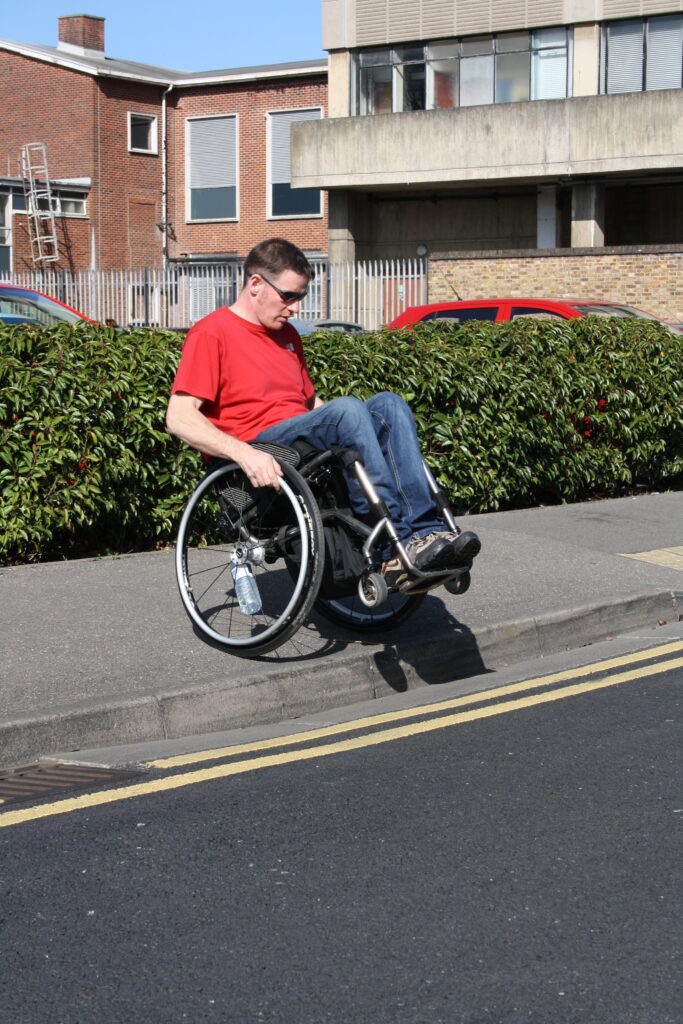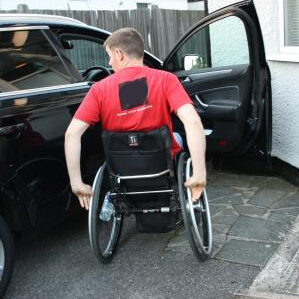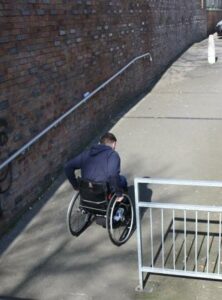Wheelchair skills, why would you want to learn them? Being able to get around confidently using my wheelchair is vital to maintaining my independence. The individual skills combined make it look like the chair is part of me. If my wheelchair set up was not to my specific needs, then propelling it and taking on the environmental challenges, which I do regularly, would be harder to conquer and could result in muscle discomfort or even damage to body parts. I offer vital wheelchair skills training in order for people to develop their skills and be more independent.
Push it along
Having a good pushing technique is important to get the most use out of a wheelchair. Make the wheelchair do the work for the user. As the wheelchair works, this gives you time to rest, saving energy, which will help with going further for longer.
In any event, it would be unlikely to not come across a camber on the path when propelling. Keeping the wheelchair continually moving and adjusting the speed of one wheel at the same time as pushing the opposite wheel is key to controlling a wheelchair when faced with an angle on the path.
You don’t need to BWB
Coming up towards kerbs can be daunting, but negotiating them safely can prevent any hold-ups with the onward journey. It’s good to be able to show confidence with Back Wheel Balance before taking on kerbs. This is to know individual limitations. You don’t want to lift those front casters too much and tip right back or not lift them high enough and catch the kerb attempting to ascend. When ascending a kerb, if the timing of lifting the front casters is out, the whole manoeuvre is unlikely to be accomplished. Best to stop, take a breath and revisit the skill.
Once up and when the need to descend a height is encountered, lifting the front casters, keeping them elevated, and moving forward on the rear wheels will result in a safe, controlled drop down the height.

Dropping down a kerb in a controlled manner. 
Kerb Ascent.
Getting around
At home, around a friends house, in the pub or dodging someone in the supermarket, turning a wheelchair to avoid obstacles can help prevent cracking knuckles against a door frame, or scuffing against a piece of furniture or even having to apologize to someone for catching their ankle! It’s a similar principle to pushing along a cambered path. Slowing one wheel down while at the same time adding energy to the accompanying wheel to keep the wheelchair moving. For tight turns, adjusting the technique provides the means to do this. You may or may not need to apply muscle to the outside wheel; it just depends on how quick you want to turn.
Looking back

The most important part of reversing is checking behind before moving. Keep an eye out for anything that might cause the wheelchair to stop without warning. Even the smallest thing, like a Lego brick, can be a hindrance. But don’t just check once; repeated checking is a principle to keeping safe and unhurt, especially if you live with children, cats and dogs.
Slopes
You can’t avoid them! They are vitally necessary if you want to be able to access certain places. Especially older buildings that don’t comply, or cannot comply, with the DDA (Disabled Discrimination Act). The steeper the incline, the more challenging it is to be able to get to the top. Adjusting the pushing technique and body position will aid in making this easier. There are a couple of different techniques depending on the lei of the land that can get used to arriving at the top. Descents can be entertaining, but the need for caution is overriding to having fun. If the front casters suddenly stop while the pace is fast, then catastrophe could occur. Descent in a controlled manner is best, whether on the rear wheels (if the back wheel balance is good) or steadily on four wheels.

Carrying
No one available to help carry a cuppa? Let’s not place it between our legs, shall we! This can cause many problems – burns, sores and the look of incontinence. Using different methods to carry an item is combined with the surroundings and type of flooring being underfoot. Carpets of different piles can be a struggle, whatever way you carry and propel at the same time. Tiles, lino and wooden flooring are the best surfaces to be able to get around with ease. If out & about, asking the brasserie is the safest, and they’re always happy to comply!
Steps
Probably the most daunting challenge that a wheelchair user can face. Thanks to the DDA, most modern buildings should have step-free access – but this is not guaranteed! Step accent is challenging and can be scary. Many factors can go wrong, and sustaining an injury can be a consequence of a mistake. A shoulder injury is just one. When considering step descent, certain factors need to be taken into account to descend safely. Control of the wheelchair in the back wheel balance is just a small part, and the size of the step is another. Going down backwards can be the safer option, but only if there is a handy handrail to hold body weight and control the speed of descent.
Wheelchair training
The wheelchair skills training available to individuals can be limited and possibly provided by professionals who may not have a physical need. Freedom Wheelchair Skills offers peer-led training, which is available to everyone. Many tips and actions can help develop individual skills that only someone who lives it can share.
